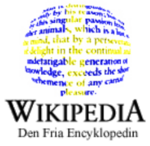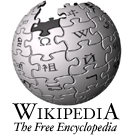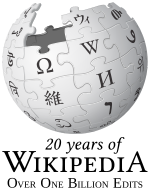User:Artemis Andromeda/sandbox/Wikipedia logo
Design and history[edit]
Provisional logo[edit]

Prior to development of the proper logo, Wikipedia used the flag of the United States, as the provisional logo for its website. It was added to the website by Jimmy Wales on 15 January 2001.[1]
First logo[edit]
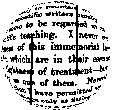
Wikipedia's first true logo was an image that was originally submitted by Bjørn Smestad, under the username Bjornsm, for a Nupedia logo competition which took place in 2000.[2] It was used as the logo the website until the end of 2001.[3]
The logo included a quote from the preface of the 1879 book Euclid and his Modern Rivals by Lewis Carroll. It utilized the fisheye effect, which made only the part of the text readable. The used text was:[3]
In one respect this book is an experiment, and may chance to prove a failure: I mean that I have not thought it necessary to maintain throughout the gravity of style which scientific writers usually affect, and which has somehow come to be regarded as an ‘inseparable accident’ of scientific teaching. I never could quite see the reasonableness of this immemorial law: subjects there are, no doubt, which are in their essence too serious to admit of any lightness of treatment – but I cannot recognise Geometry as one of them. Nevertheless it will, I trust, be found that I have permitted myself a glimpse of the comic side of things only at fitting seasons, when the tired reader might well crave a moment’s breathing-space, and not on any occasion where it could endanger the continuity of the line of argument.
Second logo[edit]
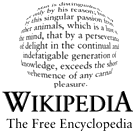
In November 2001, Wikipedia users began suggesting new logos for the website. A list of 24 leading candidates was chosen in the contest, which took place from November to December 2001. The winner was the last logo (#24), contributed by the user The Cunctator.[3]
The logo included the quote, taken from Thomas Hobbes's 1651 book Leviathan, from chapter VI of part I, placed within the circle and distorted by the fisheye effect. Underneath it was written "Wikipedia" in the capital letters, with W and A being slightly taller than the other. Beneth that, was placed motto of Wikipedia: The Free Encyclopedia.[3] The text used for the logo was:
Desire to know why, and how, curiosity; such as is in no living creature but man: so that man is distinguished, not only by his reason, but also by this singular passion from other animals; in whom the appetite of food, and other pleasures of sense, by predominance, take away the care of knowing causes; which is a lust of the mind, that by a perseverance of delight in the continual and indefatigable generation of knowledge, exceedeth the short vehemence of any carnal pleasure.
As the logo utilized text in English language, its usage wasn't favored by other-language versions of Wikipedia. Some websites used similar designs with texts in their own languages. For example, Dutch Wikipedia used text from Multatuli's 1860 Max Havelaar classic book.[4] Other websites used the logo with English text, pained in the colours of the national flags. Such design was used for example by Danish and Swedish versions, using the flags of Denmark and Sweden, respectively.[5][6] The other option used by some versions of Wikipedia was to design their own distinct logos, for example the French Wikipedia, which used the golden (yellow) circle with a white dove on it, as its logo.[7] Additionally, some websites used a logo with English text in it, with the motto "The Free Encyclopedia" translated to their languages. It was done, for example, by the German Wikipedia.[8]
Third logo[edit]
In 2003, following a suggestion by Erik Möller, known under the username Eloquence, an international logo contest was conducted to find a new logo that was suitable for all language versions of Wikipedia.[9][10] After a two-stage voting process, a design by Paul Stansifer, at the time known under username Paullusmagnus, won with considerable support. His project depicted an unfinished globe constructed of puzzle pieces, of multiple colors. It was covered by text with links in various languages and writing systems, to symbolize the continuous construction and development of the project. It was made in POV-Ray, using a puzzle image wrapped around a sphere.[10]

A ratification vote was held soon after, to confirm community consensus. As a result, twelve direct adaptations of the design were created by members of the community. One of the propositions made by David Friedland, known under username Nohat, was chosen. Friedland removed the color and changed the overlaid text into one letter or symbol per puzzle piece. His design included various characters from various writing systems. The writing in the logo used Hoefler Text font. Before being officially released, the logo slightly lightened up and had replaced nearly obsolete kana wi (ヰ) from katakana script with modern kana wa (ワ) and small i (ィ). It was adopted by the English Wikipedia on 26 September 2003.[10]
The logo included 16 characters from 16 different writing scripts, many of which—but not all, chosen to represent due to their similarity to letter W from English language, as in the name Wikipedia. The alphabets represented were as follows:[10]
- at left, from the top down: capital letter ini (Ի, transcription: i) from Armenian alphabet, letter lo (ល) from Khmer script, combined letters wa and i (ཝི) from Tibetan script, combined letters va and i (वि, transcription: vi) from Devanagari script, and the letter Todo I (ᡅ; transcription: i) from Mongolian script, that was rotated 90 degrees;
- in the middle-left column, from the top down: capital letter omega (Ω; transcription: o) or capital letter omega with smooth breathing (Ώ) from Greek alphabet, and radical 145+5 (袓, pinyin: jù, jiē) from Simplified Chinese script;
- in the middle-right column, from the top down: kanas wa and small i (ワィ, romanization: fi) from Japanese katakana script, letter W from Latin script, capital letter i (И; transctipion i) or short i (Й; transctipion: y) from Cyrillic script, and resh (ר, transcrition: r) from Hebrew alphabet;
- the rightmost column, from the top down: letter r () from Klingon pIqaD script, isolated letter yodh (ي) from Arabic script, sylabe wi (위) from Korean hangul script, and letter cha (ฉ) from Thai script.
The logo included several mistakes. Due to a formatting error, letters va and i (वि) from Devanagari script, were wrongly rendered, being reversed in the process, showing as वि. In the combined letters va and i (ವಿ) from Kannada script, the diacritic was attached to the wrong place. In the case of the Japanese katakana, there was used a wrong kana. Wa (ワ) was mistakenly used instead of kana u (ウ), forming the constant fi (ワィ), instead of wi (ウィ), which is present in the Japanese name of the website, Wikipedia (ウィキペディア).[10]
Armenian ini (Ի) |
— | — | — |
Khmer lo (ល) |
— | Japanese Katakana wa + i (ワィ) |
Klingon r () |
 Tibetan wa + i (ཝི) |
Greek omega or omega with tonos (Ω or Ώ) |
 Latin W (W) |
 Arabic yodh (ي) |
Devanagari va + i (वि) |
Chinese radical 145+5 (袓) |
Cyrillic I or Short I (И or Й) |
 Korean Hangul wi (위) |
 Mongolian Todo I (rotated 90 degrees) (ᡅ) |
Kannada va + i (ವಿ) |
Hebrew resh (ר) |
 Thai cho (ฉ) |
2010 redesign[edit]

In late 2009, the Wikimedia Foundation undertook the efforts to fix the errors and generally update the puzzle globe logo. Among other concerns, the original logo did not scale well and some letters appeared distorted.[11] For the new logo, the Wikimedia Foundation defined which characters appear on the "hidden" puzzle pieces, and had a three-dimensional computer model of the globe created to allow the generation of other views.[12] A partial 3D globe was commissioned for the Wikimedia office.[13]
The new design has been published in May 2010. It features the new 3D rendering of the puzzle globe, as well as correct versions of previously wrong characters, including fixed versions of letters from Kannada and Devanagari, and usage of correct Japanese katakana characters. Additionally, several letters had been replaced by others. It included:[14][15]
- ini (Ի) being replaced with vev (Վ), both originating from the Armenian alphabet;
- letter lo (ល) being replaced with combined letters vo and i (វិ), both originating from the Khmer script;
- combined letters wa and i (ཝི) from Tibetan script being replaced by short u (উ) letter from Bengali–Assamese script, while Tibetan character was moved elsewhere;
- letter Todo I (ᡅ) from Mongolian script being replaced by letter vini (ვ) from the Geogrian Mkhedruli script;
- radical 145+5 strokes (袓) from Simplified Chinese script being replaced by radical 120+8 strokes (維) from the Traditional Chinese script.
- letter resh (ר) being replaced by letter waw (ו), both originating from the Hebrew alphabet;
- r () from Klingon pIqaD script being replaced by letter wə (ው) from the Geʽez script;
- letter yodh (ي) being replaced by letter waw (و), both originating from the Arabic script;
- letter cho (ฉ) being replace by combined letters wo waen and sara i (วิ), both originating from the Thai script.
The wordmark has been modified from the Hoefler Text font to the open-source Linux Libertine font, and the subtitle was no longer italicized. The "W" character, which was used in various other places in Wikipedia, such as the favicon, and was seen as an distinctive part of the Wikipedia brand, was stylized as crossed V's in the original logo, while the W in Linux Libertine was rendered with a single line. To provide the traditional appearance of the Wikipedia "W", a "crossed" W was added as an OpenType variant to the Linux Libertine font.[15]
For the new logo had been designed the entire surface of its globe, including puzzle pieces hidden on the non visible parts of the logo. In total, there were designed 51 puzzle pieces, of which 18 were visible in the logo. There were 21 empty spaces left, for the missing puzzles.
The visible puzzle pieces are:[10][16]
- in the leftmost column, from the top down: capital letter vev (Վ, transcription: v) from the Armenian alphabet, combined letters vo and i (វិ, transcription: vi) from the Khmer script, letter short u (উ, transcription: u) from the Bengali alphabet, combined letters va and i (वि, transcription: vi) from Devanagari script, letter vini (ვ, transcription: v) from Georgian mkhedruli scrip;]
- in the middle-left column, from the top down: capital letter omega (Ω, transcription: o) from the Greek alphabet, the Radical 120 with 8 additional strokes]] (維) from the Traditional Chinese script, letter vi (ವಿ, transcription: vi) from the Kannada script, combined letters wa and i (ཝི, transcription: wi) from the Tibetan script.
in the middle-right column, from the top down: kanas u and small i (ウィ, romanization: wi) from the katakana script, capital letter W (W) from the Latin script, capital letter i (И, transcription: i) from the Cyrillic script, letter waw (ו, transcription: v) from the Hebrew alphabet, combined letters va and i (வி, transcription: vi) from the Tamil script;
- in the rightmost column, from the top down: letter wə (ው, transcription: wə) from the Geʽez script, isolated letter waw (و, transcription: w) from the Arabic alphabet, combined letters ieung, u and i (위, transcription: wi) from the Hangul script, combined letters wo waen and sara i (วิ, transcription: vi) from the Thai script.
The puzzle pieces from the not visible portion of the logo are:[10][16]
- in the central left column, from the top down: capital letter V (V) from the Latin script, combined letters yodh and aleph (يا, transcription: yā) from the Arabic alphabet;
- in the first row to the left from the central left column, from the top down: capital letter wi (Ꮻ, transcription: wi) from the Cherokee syllabary, letter wa (ᥝ, transcripion: v) from the Tai Le script, capital letter pi (Π, transcription: p) from the Greek alphabet;
- in the second row to the left from the central left column, from the top down: combined letters va and i (వి, transcription: vi) from the Telugu script, capital letter E-acute (É) from the Latin script, combined letters v and i (ဝီ, transcription: vi) from the Mon–Burmese script, letter o (ᐅ, transcription: o) from the Canadian Aboriginal syllabics, combined letters wa and i (ᤘᤡ) from the Limbu script;
- in the third row to the left from the central left column, from the top down: letter uuinne (𐍅, transcription: w) from the Gothic alphabet, letter u (ଉ, transcription: u) from the Odia script, combined letters va and i (വി, transcription: vi) from the Malayalam script, letter wa (ᠸ, transcription: w) from the Mongolian script;
- in the fourth row to the left from the central left column, from the top down: combined letters va and i (વિ, transcription: vi) from the Gujarati script, combined letters wa and i (ᨓᨗ, transcrition: wi) from the Lontara script, letter vedi (Ⰲ, transcritpion: vi) from the Glagolitic script, capital letter U (U) from the Latin script;
- in the central right column, from the top down: capital letter de (Д, transcription: d) from the Cyrillic script, capital dotted I (İ) from the Latin script;
- in the first row to the right from the central right column: combined letters va and i (වි, transcription: vi) from the Sinhala script;
- in the second row to the right from the central right column, from the top down: combined letters vava and sihari (ਵਿ, transcription: vi) from the Gurmukhi script, combined letters vaavu and i (ވި, transcription: vi) from the Thaana script, capital letter H (H) from the Latin script, capital letter A-umlaut (Ä) from the Latin script;
- in the third row to the right from the central right column, from the top down: capital letter ya (Я, transcription: ya), combined letters w and i (ວິ, transcription: vi) from the Lao script, capital letter u (У, transcription: u) from the Cyrillic script, radical 12 with additional 6 strokes (典, pinyin: diǎn) from the Traditional Chinese script;
- in the fourth row to the right from the central right column, from the top down: combined letters wa and i (ꦮꦶ, transcription: wi) from the Javanese script, isolated letter waw (ܘ, transcription: w) from the Syriac alphabet, capital letter ve (В, transcription: v) from the Cyrillic script, letter wi (ᜏᜒ, transcription: wi) from the Baybayin script.
| — | — | — | |||||||
| — | — | — | |||||||
| — | — | — | — |  Armenian vev (Վ) |
— | — | — | — | — |
| — | — | — |  Telugu va + (i) (వి) |
 Khmer vo + i (វិ) |
— |  Katakana u + small i (ウィ) |
 Gəʿəz wə (ው) |
— | — |
 Javanese wa + i (ꦮꦶ) |
 Gujarati va + i (વિ) |
 Gothic vinja (𐍅) |
 Latin E-acute (É) |
 Bengali short u (উ) |
 Greek omega (Ω) |
 Latin W (W) |
 Arabic wāw (و) |
 Gurmukhī vava + sihari (ਵਿ) |
![the last LETTER of most Wikipedias using the Cyrillic Alphabet [citation needed]](http://upload.wikimedia.org/wikipedia/commons/thumb/6/67/Cyrillic_%D0%AF.svg/60px-Cyrillic_%D0%AF.svg.png) Cyrillic ya (Я) |
 Syriac wāw (ܘ) |
 Lontara w + i (ᨓᨗ) |
 Oriya U (ଉ) |
 Burmese script v + i (ဝီ) |
 Devanagari va + i (वि) |
 Traditional Chinese (維) |
 Cyrillic i (И) |
 Hangul/Chosongul wi (위) |
 Tāna vaavu + (i) (ވި) |
 Laotian w + i (ວິ) |
 Cyrillic ve (В) |
 Glagolitic vědě (Ⰲ) |
 Malayalam va + short i (വി) |
 Inuktitut short u (ᐅ) |
 Georgian vin (ვ) |
 Kannada va + (i) (ವಿ) |
 Hebrew vav (ו) |
 Thai wo waen + sara i (วิ) |
 Latin H (H) |
 Cyrillic u (У) |
 Tagalog Baybayin wi (ᜏᜒ) |
 Latin U (U) |
 Mongolian wa (ᠸ) |
 Limbu wa + i (ᤘᤡ) |
 Cherokee wi (Ꮻ) |
 Tibetan wa + (i) (ཝི) |
 Tamil va + (i) (வி) |
 Sinhala va + i (වි) |
 Latin A-umlaut (Ä) |
 Chinese character (典) |
 Tai Nüa wa (ᥝ) |
 Latin V (V) |
 Cyrillic de (Д) |
|||||||
 Greek pi (Π) |
 Arabic yāʾ + ʾalif (يا) |
 Latin dotted I (İ) |
|||||||
Anniversary logos[edit]
10th anniversary logo[edit]

On 15 January 2011, a special logo replaced the standard globe on the English Wikipedia in order to mark the tenth anniversary of Wikipedia's founding. The logo depicts a single black jigsaw piece, representing the addition of another piece to the puzzle. On it is written "10 years".[17]
20th anniversary logos[edit]
On 14 January 2021, a 4-sectioned logo was used instead of the puzzle globe on the English Wikipedia, in order to mark the 20th anniversary of Wikipedia. The 4 sections, depict, in clockwise order, starting from the top-left:
- yellow background, a woman reading a book with the "W" on it, signifying Wikipedia;
- blue background, a computer showing a blue screen with a "W" on it, signifying Wikipedia;
- red background, a phone showing a blue screen with a "W" on it, signifying Wikipedia;
- green background, the normal Wikipedia globe, in blue, but with most letters aside from the "W" being replaced with various other objects and symbols.[18][19]
On 22 January 2021, the previous anniversary logo was replaced with a less striking version, consisting of the normative Wikipedia globe above the text "20 years of Wikipedia – Over One Billion Edits".[20]
Physical recreations[edit]

In 2009, Wikimedia Foundation had put a 3D printed signage depicting a life-size half of the Wikipedia globe, in its headquarters in San Francisco, California, United States. It was a made by Because We Can build and design firm based in Oakland, California.[21]

On 22 October 2014, in the town of Słubice, Poland, was unveiled the Wikipedia Monument, a statue by sculptor Mihran Hakobyan honoring Wikipedia contributors. The monument depicts four nude figures holding aloft a globe based on the Wikipedia logo, reaching over two metres (6 ft 7 in) up, made out of the fiber and resin. It is the world's first monument to the online encyclopedia.[22][23][24]Cite error: A <ref> tag is missing the closing </ref> (see the help page).

On 29 September 2017, the sculpture of the logo of Wikipedia was submerged to the bottom of Lake Sevan in Armenia, to form an artificial reef. It was done thanks to the joint efforts of the Wikimedia Armenia community and ArmDiving divers' club. The 2 metre-wide and 2 metre-high (6 ft 7 in by 6 ft 7 in) sculpture (the largest depiction of Wikipedia logo in the world) was made in Armenia for the annual meeting of the Central and Eastern Europe Wikimedia affiliates, Wikimedia CEE Meeting that the country hosted in August 2016 in Dilijan.[25]
Trademark[edit]
This section needs expansion with: registration status in the USA and other countries. You can help by adding to it. (September 2011) |
The logo was registered as a Community Trade Mark of the European Union by Wikimedia Foundation, Inc. The trade mark bears a filing date of 31 January 2008 and a registration date of 20 January 2009.[26]
On 24 October 2014, the Wikimedia Foundation released the logo, along with all other logos belonging to the Foundation, under the Creative Commons Attribution-ShareAlike 3.0 license.[27]
References[edit]
- ^ "OldWikiPediaLogo". meta.wikimedia.org.
- ^ "Submitted Logos". nupedia.com.
- ^ a b c d Ayers, Phoebe; Matthews, Charles; Ayers, Ben (2008). How Wikipedia Works: And how You Can be a Part of it. No Starch Press. p. 47. ISBN 9781593271763.
- ^ "Hoofdpagina". nl.wikipedia.org (in Dutch). 8 August 2003.
- ^ "Forside". da.wikipedia.org (in Danish). 6 August 2003.
- ^ "Huvudsida". sv.wikipedia.org (in Swedish). 2 February 2002.
- ^ "Accueil". fr.wikipedia.org (in French). 7 February 2003.
{{cite web}}:|archive-url=requires|archive-date=(help) - ^ "Hauptseite". de.wikipedia.org (in German). 7 February 2003.
- ^ "[Wikipedia-l] Do we need a new logo contest?". lists.wikimedia.org.
- ^ a b c d e f g Cohen, Noam (June 25, 2007). "Some Errors Defy Fixes: A Typo in Wikipedia's Logo Fractures the Sanskrit". The New York Times. Archived from the original on September 5, 2017. Retrieved February 23, 2017.
- ^ ""brand new" about new logo". Archived from the original on 2013-05-24. Retrieved 2010-11-12.
- ^ "Wikimedia blog – Wikipedia in 3d". 13 May 2010. Archived from the original on 2013-05-24. Retrieved 2010-11-12.
- ^ The work was done by the Because We Can Archived 2012-08-31 at the Wayback Machine studio, based on the new digital 3D model.
- ^ Jay Walsh (13 May 2010). "Wikipedia in 3D". diff.wikimedia.org.
- ^ a b Poll, Philipp H. "New Wikipedia-Logo using LinuxLibertine". Libertine Open Fonts Project. Archived from the original on 2010-06-30. Retrieved 2018-08-09.
- ^ a b "About the official Marks". foundation.wikimedia.org.
- ^ "Anniversary celebrations; Foundation reports; local language problems; brief news". en.wikipedia.org. 17 January 2011.
- ^ "Celebrating 20 years of Wikipedia". wikimediafoundation.org.
- ^ "Main Page". en.wikipedia.org. 15 January 2021.
- ^ "Main Page". en.wikipedia.org. 23 January 2021.
- ^ "The Wikipedia Globe, now in 3D!". bwcarchitects.com. 30 October 2009.
- ^ "Poland to Honor Wikipedia With Monument". ABC News. 9 October 2014. Archived from the original on 11 October 2014. Retrieved 9 October 2014.
- ^ Cite error: The named reference
telegraphwas invoked but never defined (see the help page). - ^ "W nowosolskim Malpolu powstaje pierwszy na świecie pomnik Wikipedii" (in Polish). 10 October 2014. Archived from the original on 14 October 2014. Retrieved 13 October 2014.
- ^ "World's largest Wikipedia logo now sits on bottom of Lake Sevan". Archived from the original on 2017-10-04. Retrieved 2017-10-03.
- ^ "Case details for Community Trade Mark E6671838". ipo.gov.uk. UK Intellectual Property Office. January 20, 2009. Archived from the original on January 15, 2021. Retrieved December 18, 2013.
- ^ "Wikimedia Logos Have Been Freed! « Wikimedia blog". 25 October 2014. Archived from the original on 2017-04-24. Retrieved 2015-04-30.


